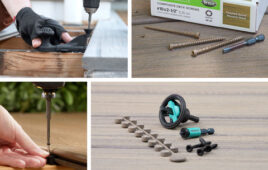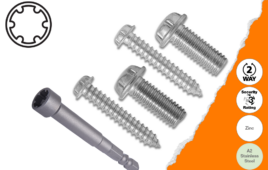
Self-drilling, flat-head screws.
Screws that have particularly sharp threads, which can carve into a material, are often referred to as self-drilling screws. However, there’s a distinction worth noting when working with these types of screws that can make a significant difference in their use and application.
Typically, the screws are categorized into two types that are defined as “self-drilling” or “self-tapping” — and these types are not interchangeable. Technically, both of these types of screws will tap their own threads (as most screws do to some degree), but the self-drilling screws are unique.
The tip of a self-drilling screw is shaped with a point and flute that resembles a drill bit. A notched area in the tip behaves as a reservoir to receive chips or filings as the material is carved away by the screw (when drilled). Thanks to this specialized tip, the self-drilling screw allows assemblers to skip the initial step of drilling a pilot hole. This feature makes self-drilling screws a time-saving and cost-effective choice for certain applications.
In contrast, a self-tapping screw typically requires an initial pilot hole before the fastening process can begin, and can have a sharp, flat, or blunt tip. These types of screws are still incredibly common, with several styles and types available (and may also be referred to by their intended use — such as concrete, drywall, or wood screws). When choosing the correct type of screw, it’s important to first consider the application, including the thickness and hardness of the material.
Here’s a rule of thumb: All self-drilling screws are self-tapping, but not all self-tapping screws are self-drilling.
Essentially, a self-drilling screw is a self-tapping screw with the added feature of the drill point. With either type, the screws carve mated threads into the substrate for a tight fit. Both types of screws are typically made out of hard steel or stainless steel that has been treated to increase its hardness. A screw must be stronger and more durable than the material it will drill into to prevent failure of the joint or damage to the screw, material, or fastening tool.

Zinc-coated, self-tapping screws.
These screws rarely require lock washers or other types of locking fasteners to prevent loosening.
Self-tapping and self-drilling screws are typically the fasteners of choice for construction, HVAC (heating, ventilation, and air conditioning), and other industries because of their ability to create a precise fit. They can be used to fasten several different materials, such as metal, aluminum, wood, drywall, and plastic. Self-tapping screws are also suitable for thin sheet metal (one or two layers) and masonry applications.
Like most fasteners, these screws are also available in a wide variety of sizes. Manufacturers often recommend an applied force and driver motor speeds when fastening a self-tapping or self-drilling screw, based on the screw size.
Bottom line: although all self-drilling screws are self-tapping screws, these two fasteners are not interchangeable. Mixing up the two can lead to errors and application failures.





Tell Us What You Think!